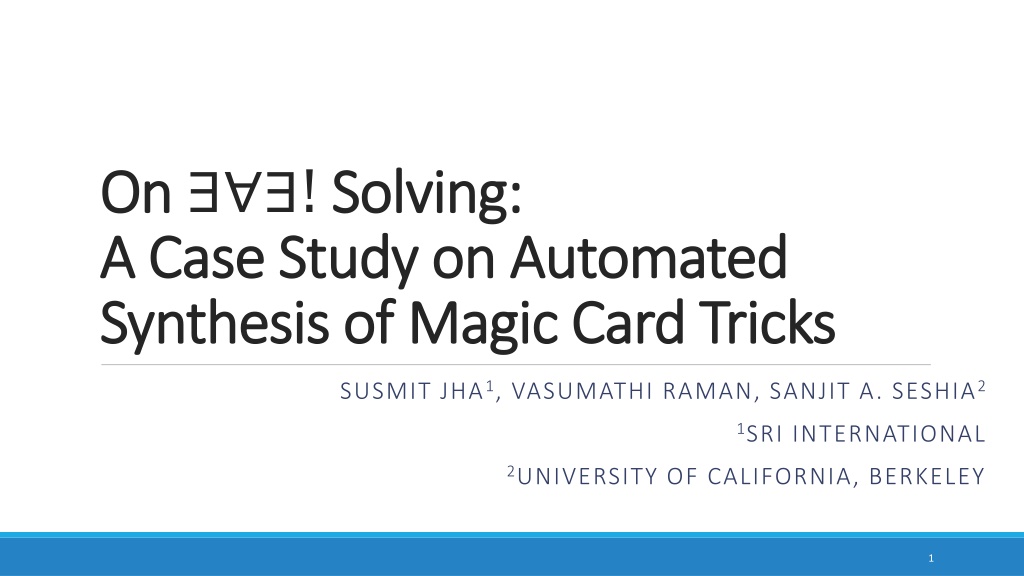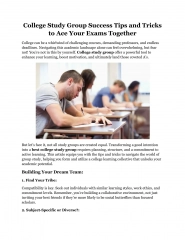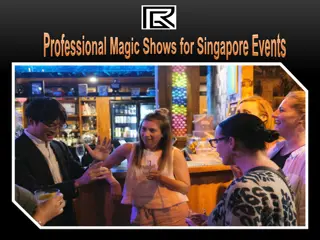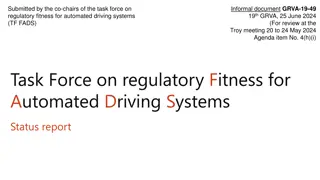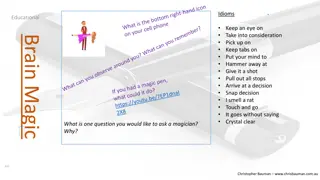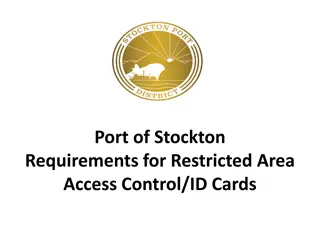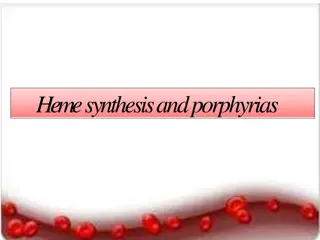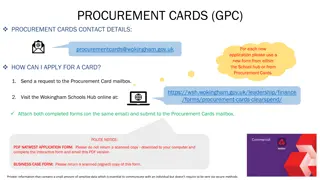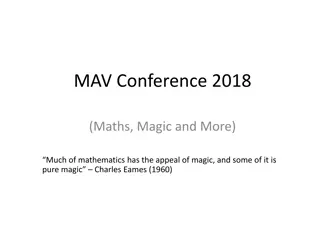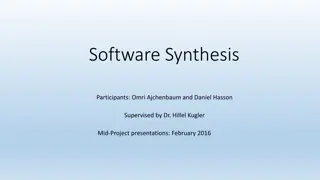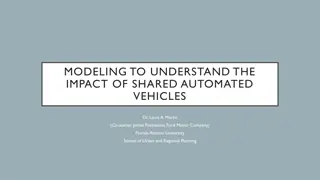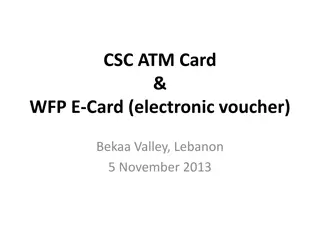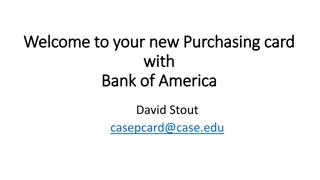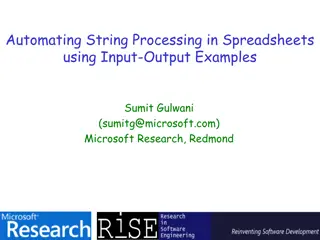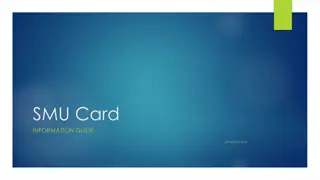Automated Synthesis of Magic Card Tricks: A Case Study
Explore the intriguing world of automated synthesis applied to the creation of magic card tricks. Delve into high-level specifications, formal synthesis processes, and captivating card trick examples involving 4 cards. Witness the magic unfold as the bottom card always emerges as the odd one, experience unique card manipulations, and be amazed by the interactive audience choice tricks. Unleash the power of formal artifact generation and discover the art of crafting mesmerizing card illusions.
Download Presentation

Please find below an Image/Link to download the presentation.
The content on the website is provided AS IS for your information and personal use only. It may not be sold, licensed, or shared on other websites without obtaining consent from the author. Download presentation by click this link. If you encounter any issues during the download, it is possible that the publisher has removed the file from their server.
E N D
Presentation Transcript
On On ! Solving: A Case Study on Automated A Case Study on Automated Synthesis of Magic Card Tricks Synthesis of Magic Card Tricks Solving: SUSMIT JHA1, VASUMATHI RAMAN, SANJIT A. SESHIA2 1SRI INTERNATIONAL 2UNIVERSITY OF CALIFORNIA, BERKELEY 1
Formal Synthesis Given a high-level specification explicitly in a logical form or implicitly as an oracle, generate a formal artifact (program/controller/plan) that satisfies the specification. The space of possible artifacts often represented as a parametric space and synthesis reduces to efficiently searching over this space. Missing constants/holes in a program: A. Solar-Lezama, L. Tancau, R. Bodik, S. A. Seshia, and V. A. Saraswat, Combinatorial sketching for finite programs. in ASPLOS, 2006, pp. 404 415 Composition of component functions: S. Jha, S. Gulwani, S. A. Seshia, and A. Tiwari, Oracle-guided component- based program synthesis, in ICSE, 2010, pp. 215 224 Successful application in synthesizing programs, plans, controllers, invariants 2
Card Trick: Example with four cards J --- Back Q K A --- Front Trick Summary: Irrespective of the choice from the users, we can ensure that the bottom most card (Jack) will always end up being the odd facing card. 5
Card Trick: Top Card to Bottom J --- Back Q K A --- Front A --- Back J Q K --- Front 6
Card Trick: Turn over the top card A --- Back J Q K --- Front A --- Back J Q K --- Front 7
Card Trick: Straight Cut (Audience Choice) K --- Back A J Q --- Front Q --- Back K A J --- Front J -- Front Q K A --- Back A --- Back J Q K --- Front A --- Back J Q K --- Front 8
Card Trick: Turn over top two together K --- Back A Q J --- Front Q --- Back K J A --- Front J -- Front Q A K --- Back A --- Back J K Q --- Front K --- Back A J Q --- Front Q --- Back K A J --- Front J -- Front Q K A --- Back A --- Back J Q K --- Front 9
Card Trick: Loop of Audience Choice Repeat{ // As many times as audience chooses Straight Cut // Audience Choice Turn over top two together } 10
Card Trick: After a few iterations K --- Back A Q J --- Front 11
Card Trick: Turn over the top card K --- Back A Q J --- Front K --- Back A Q J --- Front 12
Card Trick: Put it to bottom K --- Back A Q J --- Front J --- Back K A Q --- Front 13
Card Trick: Put top to bottom again Q --- Back J K A --- Front J --- Back K A Q --- Front 14
Card Trick: Turn Over the Top Card Q --- Back J K A --- Front Q --- Back J K A --- Front 15
Card Trick: Odd facing card ! Q --- Back J K A --- Front Q --- Back J K A --- Front 16
Card Trick: Example Specification/Property The card which was at the bottom of the stack in the beginning is always odd-facing card at the end ! Take 4 card all facing down Put top card to bottom Turn over top card Turn top card Repeat { //Audience choice on how many times Straight Cut (at position of Audience Choice ) Turn over top two together } Turn over top card and put it to bottom Put top card to bottom Turn over top card Magic Card Trick: Non-deterministic Program Inputs at different steps 17
Card Trick: Example Specification/Property The card which was at the bottom of the stack in the beginning is always odd-facing card at the end ! Take 4 card all facing down Put top card to bottom Turn over top card Turn top card Repeat { //Audience choice on how many times Straight Cut (at position of Audience Choice ) Turn over top two together } Turn over top card and put it to bottom Put top card to bottom Turn over top card Turn over top card and put it to bottom Put top card to bottom Turn over top card Turn over top card and put it to bottom Put top card to bottom Turn over top card Turn over top card and put it to bottom Put top card to bottom Turn over top card SYNTHESIS Take 4 card all facing down Put top card to bottom Turn over top card Turn top card Repeat { //Audience choice on how many times Straight Cut (at position of Audience Choice ) Turn over top two together } Straight Cut (at position of Audience Choice ) Turn over top two together } Straight Cut (at position of Audience Choice ) Turn over top two together } Take 4 card all facing down Put top card to bottom Turn over top card Turn top card Repeat { //Audience choice on how many times Turn over top card Turn top card Repeat { //Audience choice on how many times Take 4 card all facing down Put top card to bottom Components 18
Component Based Synthesis 1. Straight-line program : Sequence of actions 2. Non-deterministic input to some actions in form of choice from audience ??1??2 ?1 ?2 ! ?0 ?1 ?????,?,? ? ?0,?? 19
Composing Component Actions 1. A magic trick is a straight-line program : Sequence of component actions 2. Non-deterministic input to some actions in form of choice from audience State is function of previous state and choice of audience. ??1??2 ?1 ?2 ! ?0 ?1 ?????,?,? ? ?0,?? 20
CEGIS: Counterexample guided synthesis Learn from example choices Generate a random sequence ??1??2 ??1??2 ?0 ?1 [ ?? ?????,??,? ? ?0,?? ] Use verification to obtain counterexample choices Obtain counterexample choice Y ?1 ?2 ?0 ?1 [ ?????,?,? ? ?0,?? ] Learn from example choices Final Magic Sequence Iterate till no counterexample choice left. 21
Results 1. Baby Hummer : A magic trick of length 10-15, 6 variants of the original trick. 2. Elmsley Shuffles: Repeating in-shuffles and out-shuffles 6-10 times, placing card from any initial position in deck to any target position through apparently random shuffles. 3. Mind-reading card-trick: Distributed magic trick where three audiences cut card decks randomly and select top cards, we find each audience s card. 22
Future Work 1. Application to adversarial planning : Non-reactive Plan in presence of adversaries where plan is guaranteed to reach the goal irrespective of adversary s choice. 2. Understanding magic tricks using program analysis tools. Take 4 card all facing down Put top card to bottom Turn over top card Turn top card Repeat { //Audience choice on how many times Straight Cut (at position of Audience Choice ) Turn over top two together } Turn over top card and put it to bottom Put top card to bottom Turn over top card What is the invariant of this loop? 3. A medium to introduce and teach formal methods to students. 23
Thanks. Conclusion: Illustrates the success of formal synthesis approach to automate discover of magic tricks which has been long seen as a creative art. 24
